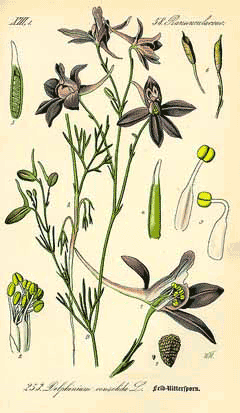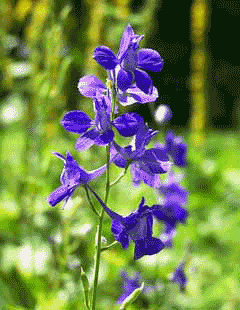 |
|
http://commons.wikimedia.org/wiki/File:Illustration_Consolida_regalis0.jpg |
 |
| http://commons.wikimedia.org/wiki/User:Teacoolish |
Translate this page:
Summary
Physical Characteristics

 Consolida regalis is a ANNUAL/BIENNIAL growing to 0.5 m (1ft 8in). It is in flower from June to July, and the seeds ripen from August to September. The species is hermaphrodite (has both male and female organs) and is pollinated by Bees, Lepidoptera (Moths & Butterflies). The plant is self-fertile.
Consolida regalis is a ANNUAL/BIENNIAL growing to 0.5 m (1ft 8in). It is in flower from June to July, and the seeds ripen from August to September. The species is hermaphrodite (has both male and female organs) and is pollinated by Bees, Lepidoptera (Moths & Butterflies). The plant is self-fertile.
It is noted for attracting wildlife.
Suitable for: light (sandy), medium (loamy) and heavy (clay) soils and prefers well-drained soil. Suitable pH: mildly acid, neutral and basic (mildly alkaline) soils. It can grow in semi-shade (light woodland) or no shade. It prefers dry or moist soil and can tolerate drought.
UK Hardiness Map
US Hardiness Map
Synonyms
Delphinium consolida.
Plant Habitats
Cultivated Beds;
Edible Uses
References More on Edible Uses
Medicinal Uses
Plants For A Future can not take any responsibility for any adverse effects from the use of plants. Always seek advice from a professional before using a plant medicinally.
Anthelmintic Diuretic Hypnotic Hypotensive Parasiticide Purgative Vasodilator
Larkspur was at one time used internally in the treatment of a range of diseases, but its only certain action is a violent purgative and nowadays it is only occasionally used in folk medicine[268]. It is of value, however, when used externally, to kill skin parasites[268]. The plant should be used with caution[9, 21], see the notes above on toxicity. The seed is anthelmintic, mildly diuretic, hypnotic, purgative and vasodilator[21]. It has been used internally in the treatment of spasmodic asthma and dropsy[4]. The flowers or the whole plant are mildly diuretic and hypotensive[9]. The expressed juice of the leaves has been considered an effective application to bleeding piles[4]. A conserve made from the flowers has been seen as a good remedy for children when subject to violent purging[4]. The juice of the flowers has also been used as a treatment for colic[4].
References More on Medicinal Uses
The Bookshop: Edible Plant Books
Our Latest books on Perennial Plants For Food Forests and Permaculture Gardens in paperback or digital formats.

Edible Tropical Plants
Food Forest Plants for Hotter Conditions: 250+ Plants For Tropical Food Forests & Permaculture Gardens.
More

Edible Temperate Plants
Plants for Your Food Forest: 500 Plants for Temperate Food Forests & Permaculture Gardens.
More

More Books
PFAF have eight books available in paperback and digital formats. Browse the shop for more information.
Shop Now
Other Uses
Dye Ink Insecticide Parasiticide
A strong tincture of the fresh seed is used externally to kill lice and nits in the head and pubic hair[4, 61, 74, 268]. It is also effective against aphids and thrips[20]. A good blue ink is obtained from the expressed juice of the petals together with a little alum[4]. It is made from the leaves according to another report[74]. It is also used as a dye[74] and is green when mixed with alum[46, 61].
Special Uses
Attracts Wildlife
References More on Other Uses
Cultivation details
An easily grown plant, it prefers a sunny position in a well-drained soil. Plants succeeded when growing in a dry shady position in the hot dry summer of 1989[K]. A very ornamental plant[1]. A greedy plant, inhibiting the growth of nearby plants, especially legumes[54]. Other reports say that it is a good companion for wheat[18, 20]. A good bee plant[74]. Plants resent root disturbance and should not be transplanted[200].
References Carbon Farming Information and Carbon Sequestration Information
Temperature Converter
Type a value in the Celsius field to convert the value to Fahrenheit:
Fahrenheit:
The PFAF Bookshop
Plants For A Future have a number of books available in paperback and digital form. Book titles include Edible Plants, Edible Perennials, Edible Trees,Edible Shrubs, Woodland Gardening, and Temperate Food Forest Plants. Our new book is Food Forest Plants For Hotter Conditions (Tropical and Sub-Tropical).
Shop Now
Plant Propagation
Seed - best sown as soon as it is ripe in situ[200]. It can also be autumn sown in areas with mild winters, otherwise sow in succession from spring to early summer[200]. The seed usually germinates in 2 - 3 weeks[200].
Other Names
If available other names are mentioned here
Native Range
TEMPERATE ASIA: Turkey, Russian Federation-Ciscaucasia (Ciscaucasia), Georgia, Russian Federation (Dagestan), Russian Federation-Western Siberia (Western Siberia) EUROPE: Denmark, Finland (south), Sweden (south), Austria, Belgium, Switzerland, Czech Republic, Germany, Hungary, Netherlands, Poland, Slovakia, Russian Federation (European part), Belarus, Estonia, Lithuania, Latvia, Moldova, Ukraine (incl. Krym), Albania, Bulgaria, Bosnia and Herzegovina, Greece, Croatia, Italy, North Macedonia, Montenegro, Romania, Serbia, Slovenia, France
Weed Potential
Right plant wrong place. We are currently updating this section.
Please note that a plant may be invasive in one area but may not in your area so it's worth checking.
Conservation Status
IUCN Red List of Threatened Plants Status :

Growth: S = slow M = medium F = fast. Soil: L = light (sandy) M = medium H = heavy (clay). pH: A = acid N = neutral B = basic (alkaline). Shade: F = full shade S = semi-shade N = no shade. Moisture: D = dry M = Moist We = wet Wa = water.
Now available:
Food Forest Plants for Mediterranean Conditions
350+ Perennial Plants For Mediterranean and Drier Food Forests and Permaculture Gardens.
[Paperback and eBook]
This is the third in Plants For A Future's series of plant guides for food forests tailored to
specific climate zones. Following volumes on temperate and tropical ecosystems, this book focuses
on species suited to Mediterranean conditions—regions with hot, dry summers and cool, wet winters,
often facing the added challenge of climate change.
Read More
Expert comment
Author
Gray.
Botanical References
200
Links / References
For a list of references used on this page please go here
Readers comment
| Add a comment |
|
If you have important information about this plant that may help other users please add a comment or link below. Only comments or links that are felt to be directly relevant to a plant will be included. If you think a comment/link or information contained on this page is inaccurate or misleading we would welcome your feedback at [email protected]. If you have questions about a plant please use the Forum on this website as we do not have the resources to answer questions ourselves.
* Please note: the comments by website users are not necessarily those held by PFAF and may give misleading or inaccurate information.
To leave a comment please Register or login here All comments need to be approved so will not appear immediately.
|
Subject : Consolida regalis
|
|
|
|